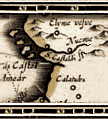Interesting Discovery of Elvish Tombs in the Morbihan
11 SEPTEMBER TARANT
This year will be remembered as a remarkable one in the annals of archaeological history,
for having been singularly productive. The resting-places of the elvish dead, always more
or less respected, afford us the largest amount of the antiquarian treasure, and assist us
in forming an idea of the manners, customs, and art of a people to whose aspirations we turn
for inspiration. Nonetheless, it is impossible for us to investigate the family barrows of
the elves in the regions of Tulla or the Glimmering Forest, due to continuing use of these
areas as cemeteries by modern-day mourners.
 It is with great excitement, then, that the curate of Tarant's Museum of Art and Antiquity,
professor William G. Harriman, is presently embarked on an expedition to the Morbihan Plains,
where a new series of ancient elvish tombs have recently been unearthed. This expedition is
not without danger; any foray into the Morbihan on foot is likely to meet with opposition from
local bandits, and in this case three men have already died at the site. Tarantian authorities
do not believe that bandits were responsible; nevertheless they refuse to speculate publicly
on what sort of marauders are currently at large in the Morbihan, or how a hale and experienced
adventurer may be found lying on his back in the dark, with a small, black-feathered elf-bolt
lodged in his throat!
It is with great excitement, then, that the curate of Tarant's Museum of Art and Antiquity,
professor William G. Harriman, is presently embarked on an expedition to the Morbihan Plains,
where a new series of ancient elvish tombs have recently been unearthed. This expedition is
not without danger; any foray into the Morbihan on foot is likely to meet with opposition from
local bandits, and in this case three men have already died at the site. Tarantian authorities
do not believe that bandits were responsible; nevertheless they refuse to speculate publicly
on what sort of marauders are currently at large in the Morbihan, or how a hale and experienced
adventurer may be found lying on his back in the dark, with a small, black-feathered elf-bolt
lodged in his throat!
Currently on the scene is the learned professor R.I. James, of the Tarantian Polytechnical
Institute, who discovered the tombs while searching the region for more of the Fossils which
have so delighted visitors to the Polytechnic's Hall of Natural History. The unprecedented
collaboration between Mssrs. James and Harriman is a unique event in the histories of their
respective institutions of employment, and perhaps heralds a new era of co-operation between
the two. In any case, the curate was most effusive in praise of the kindness and good judgement
of Professor James, who immediately sent for him when the nature of his discovery became clear.
"I cannot overstate my gratitude to Professor James," said Harriman, on the morning
that his expedition set off. "But his professional courtesy comes as no great surprise.
The gentleman is a paleontologist and not an archaeologist, of course, but our two disciplines
share many features in common. Both pursuits are subject to the heartbreak of sites being
oft-times ruined by amateur excavators, who destroy three times as much as they discover in
their clumsy efforts to unearth a major find. Fossils and antique urns share the quality of
extreme delicacy! They should only be approached by trained professionals, who can treat
them with the necessary respect."
When asked what he expects to find on the scene, the good curate waxed reticent. "I
cannot say what we will find there, good or bad," he said. "But every one of my
men is equipped with a bullet-proof vest and every magical ward we could lay hands to, on such
short notice. The councils at Tulla and Qintarra have lodged formal protests with the Museum,
and I've even been personally threatened; nonetheless, Professor James and I will hold the site
for as long as we are able. No present-day elf can possibly hold a claim to such an ancient
barrow; they weren't even aware that these burial mounds existed, until James and his party
discovered them. I suspect the dastards simply want to have first crack at what's inside!"
And what will we learn from these tombs? "In his letter to me, Professor James has raised
my hopes very high," says Harriman. "His team attempted to excavate only one of the
six hills on the Morbihan Plain, and found within it the funereal rooms of an elvish warrior.
He could not guess at the Era which might have produced this gentleman and the goods with which
he was buried, and this alone piques my professional interest! After all, the good Professor
has been a generous Fellow of our museum for many years, and is intimately familiar with all
of our exhibits. Our collection demonstrates all the known styles and periods of dynastic art
among the elven people; if James does not recognize the style in which this fallen warrior was
arrayed, the occupant of this tomb may have been buried in a time so long past that it has been
forgotten. In any case, we must find out with all haste! May the good people of Tarant wish
us luck."







